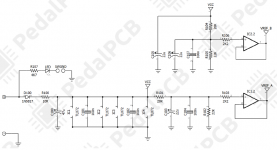Chuck D. Bones
Circuit Wizard
It just makes DC, how hard can that be? Over the course of my engineering career, one of the things I did was design power supplies. The guys who used those power supplies, RF designers, digital designers, precision analog designers, all underestimated the difficulty in designing a power supply that met their requirements. That's assuming they even knew all of their requirements. As pedal users, we want power supplies to (as a minimum):
Meeting requirement #1 means the power supply must contain regulators. Regulators use feedback to regulate their output voltage and can go unstable with certain loads. Too much capacitance, not enough capacitance, not enough current load can all cause instability. Pedal power supply designers will never know what's inside all of the pedals you might use. They take their best shot.
Requirement #2 means we need filtering, which can also lead to stability issues. Passive filters (inductors and capacitors) are bulky.
Requirement #3 we already talked about.
Requirement #4 means every output should have its own regulator. In the truest sense, isolation means that the grounds are isolated too. Many multiple-output power supplies do not have isolated grounds, they all share a common ground. Only the more expensive power supplies have isolated grounds.
Requirement #5 drives the power supply designer to use a switching regulator. That can be good or bad depending on how good the designer is at doing their job. Switching regulators are harder to stabilize and some of them won't regulate into no load. They also require more filtering and are sensitive to the board layout and routing.
Requirement #6 means the designer has to include current limiting, an electronic circuit-breaker or some other fault management strategy. Fuses are not too convenient.
Pedals that have resistor in series with their power input make life much easier for the power supply because there is a smaller surge current when the power supply starts up and has to charge the pedal's filter caps. That resistor also provides some separation between the pedal's filter caps and the regulators, which aids stability. A resistor as small as 10Ω will help.
These days, when I have a pedal with a squealing problem, first thing I check is the power supply. That's because a couple years ago I spent the better part of two days troubleshooting a Vero build only to find out that the Monoprice power supply I was using had gone unstable with that load.
- Provide the correct DC voltage under all conditions:
- high line
- low line
- high load
- low load
- start up
- Be quiet. The DC should have no AC ripple or noise riding on it.
- Be stable (not oscillate) over the range of load conditions presented by pedals.
- Provide isolation between pedals.
- Be reasonably efficient.
- Tolerate fault conditions like shorted outputs.
Meeting requirement #1 means the power supply must contain regulators. Regulators use feedback to regulate their output voltage and can go unstable with certain loads. Too much capacitance, not enough capacitance, not enough current load can all cause instability. Pedal power supply designers will never know what's inside all of the pedals you might use. They take their best shot.
Requirement #2 means we need filtering, which can also lead to stability issues. Passive filters (inductors and capacitors) are bulky.
Requirement #3 we already talked about.
Requirement #4 means every output should have its own regulator. In the truest sense, isolation means that the grounds are isolated too. Many multiple-output power supplies do not have isolated grounds, they all share a common ground. Only the more expensive power supplies have isolated grounds.
Requirement #5 drives the power supply designer to use a switching regulator. That can be good or bad depending on how good the designer is at doing their job. Switching regulators are harder to stabilize and some of them won't regulate into no load. They also require more filtering and are sensitive to the board layout and routing.
Requirement #6 means the designer has to include current limiting, an electronic circuit-breaker or some other fault management strategy. Fuses are not too convenient.
Pedals that have resistor in series with their power input make life much easier for the power supply because there is a smaller surge current when the power supply starts up and has to charge the pedal's filter caps. That resistor also provides some separation between the pedal's filter caps and the regulators, which aids stability. A resistor as small as 10Ω will help.
These days, when I have a pedal with a squealing problem, first thing I check is the power supply. That's because a couple years ago I spent the better part of two days troubleshooting a Vero build only to find out that the Monoprice power supply I was using had gone unstable with that load.
Last edited:



